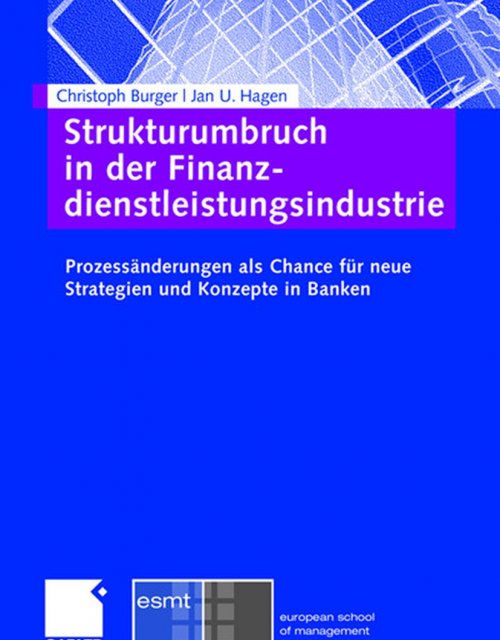Publication records
Subject(s)
Marketing
Keyword(s)
marketing, developing world, mobile, innovation, segmentation, Smart, poverty, 4Ps, marketing strategy, telecom, telecommunications, Vodafone, Orange, network
Secondary Title
Developing Analytical Skills: Case Studies in Management
Pages
445–454
ISBN
978–8184040425
Subject(s)
Strategy and general management
Keyword(s)
Strukturumbruch, Konsolidierung
Das Aufbrechen traditionell vertikal integrierter Wertschöpfungsketten wird für deutsche Banken zu einer Notwendigkeit im Erhalt um die Wettbewerbsfähigkeit. Sie folgen damit der Industrie, wo führende Unternehmen wie BMW oder Siemens in den vergangenen Jahren durch Fokussierung und gezieltes Outsourcing die Produktivität und Kostenposition deutlich verbessern konnten. Auch wenn die ersten Maßnahmen im Finanzdienstleistungsbereich noch bescheiden ausgefallen sind, ist die zunehmende Dynamik dieses Prozesses deutlich erkennbar.Das vorliegende Buch informiertüber die neuen Konzepte in der Finanzdienstleistungsindustrie und bietet Lösungsansätze zur nachhaltigen Positionierung von Retail Banking, IT-Management, Transaction Banking, Kreditwesen, Asset Management und Sanierungsmanagement.
Pages
177
ISBN
978–3834906250
Subject(s)
Human resources management/organizational behavior
Keyword(s)
leadership, change, leadership archetypes, situational leadership, leading change, transformational change, change curve
On July 29, 2004 the German Football Association (Deutscher Fußballbund; DFB) announced that Jürgen Klinsmann had been chosen to prepare the national soccer team for the World Cup, to be held in Germany in the summer of 2006. The public responded to this announcement with a great deal of surprise and skepticism; two years later - on July 11, 2006 - it would respond to Klinsmann's announcement that he would not renew his contract with even greater regret. During the two years in which Klinsmann led the team, Germany experienced a soccer revolution. True, the team and Klinsmann's staff had not realized Klinsmann's goal of winning the World Cup; the Germans came third. But in this period Klinsmann would succeed, despite considerable resistance, in introducing major reforms. He would steer a team that had hit rock-bottom both psychologically and technically back to a world-class level. The soccer team's appearance on and off the field galvanized ordinary Germans and contributed significantly to the World Cup's huge success: all its games were sold out; the mood was euphoric in the stadiums, in the public viewing areas set up in many cities, and in the streets; hundreds of thousands of Germans and foreign fans celebrated together; and images of a friendly, open Germany circulated around the world, correcting the cliche about dour Germans.
| buy now | buy now | buy now |
Subject(s)
Human resources management/organizational behavior
Keyword(s)
transitional leadership development, evaluation of leadership development programs, psychodynamic orientation to leadership development
A pdf file of this working paper may be available at INSEAD.
Pages
26
Subject(s)
Economics, politics and business environment
Keyword(s)
cartels, leniency
JEL Code(s)
K21, L41, C81, D42
Volume
4
Journal Pages
89–113
Subject(s)
Strategy and general management
Keyword(s)
Strukturumbruch, Konsolidierung
Secondary Title
Strukturumbruch in der Finanzdienstleistungsindustrie: Prozessänderungen als Chance für neue Strategien und Konzepte in Banken
Pages
147–167
ISBN
978–3834906250
Subject(s)
Strategy and general management
Keyword(s)
entrepreneurship, strategy, strategic innovation, competitive advantage
Secondary Title
Developing analytical skills: Case studies in management
Pages
419–443
ISBN
978–8184040425
Subject(s)
Strategy and general management
Keyword(s)
strategic innovation, value innovation, blue ocean strategy, business strategy, competitive strategy
Volume
23
Journal Pages
51–59
Subject(s)
Economics, politics and business environment
Keyword(s)
competition policy
Volume
6
Journal Pages
592–604
Subject(s)
Management sciences, decision sciences and quantitative methods; Marketing
Keyword(s)
Branding, brand choice, consumer behavior, decision making under uncertainty
JEL Code(s)
C91, D10, D80, M31
This paper investigates situations where a sizable sub-set of consumers prefer an inferior (dominated) offer made by an established brand to a superior (dominating) offer made by a less-established brand. Established brands are those for which consumers hold more confident beliefs concerning overall quality. Through a series of eight experiments, we test the hypothesis that the preference for a dominated established brand is linked to ambiguity aversion, a seemingly unrelated pattern of choice behavior between monetary gambles. We first show a correlation between ambiguity aversion and the preference for dominated established brands. We then demonstrate that the preference for established brands is enhanced when ambiguity aversion is made more salient in unrelated preceding choices. To further study the ambiguity-reducing properties of established brands, the last experiments assign brand names to monetary gambles, and it appears that (a priori unrelated) established brand names increase the likelihood of choosing ambiguous gambles. Overall, this research argues that brand equity for longstanding brands derives (at least in part) from consumers' tendency to avoid ambiguity.
View all ESMT Working Papers in the ESMT Working Paper Series here. ESMT Working Papers are also available via SSRN, RePEc, EconStor, and the German National Library (DNB).
Pages
28
ISSN (Print)
1866–3494
